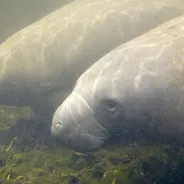A dead humpback whale has washed up ashore in the Amazon rainforest, but it is unknown exactly how the mammal died or why it was so close to the mouth of the river.
Estimates put the carcass at roughly 10 tonnes - 36 feet long. It was discovered far from the area where the species is expected to be found at this time of year. The whale was found last Friday in a woodland area of Brazil, around 50 feet from the ocean, at the mouth of the Amazon river. Scientists working on the island of Marajo have begun studies on the creature, found in the undergrowth near Araruna Beach, to determine what exactly happened.
A team of 10 specialist biologists sent by NGO the Bicho D'Agua Institute have found that the animal is a 12 month old calf, and are still hoping to find out how it died. One of the prevailing theories is that it was thrown out of the water and into the undergrowth by a combination of rough seas and high tides.
The Bicho D'Agua Institute have discussed the incident, suggesting that the whale could have become entangled in the mangroves after being thrown to the shore by the rough seas prior to Friday. Meanwhile, the Maritime Herald newspaper has posited that the whale could have died from consuming plastics dumped in the ocean, and died prior to being washed ashore.
"We only found the whale because of the presence of scavenging birds of prey," Dirlene Silva from the Brazilian environmental, health and sanitation department, SEMMA, told local media. "The vultures were spotted circling above the carcass which was found hidden in the bush some distance from the sea."
According to The Sun, Bircho D'Agua president and marine specialist Renata Emin commented:
"We're still not sure how it landed here, but we're guessing that the creature was floating close to the shore and the tide, which has been pretty considerable over the past few days, picked it up and threw it inland, into the mangrove.
"Along with this astonishing feat, we are baffled as to what a humpback whale is doing on the north coast of Brazil during February because this is a very unusual occurrence."
Emin is referring to the fact that the Humpback Whale is normally spotted in the Bahia area between the months of August and November, before they migrate up to Antartica, making its appearance here highly unusual.
"Humpback whales don't usually travel to the north. We have a record of one appearing in the area three years ago, but it's rare," she continued. "We believe this is a calf which may have been travelling with its mother and probably got lost or separated during the migratory cycle between the two continents."
The team are currently conducting various forensic tests on the whale to find out the details of its death, and the results should be found within the next ten days.












